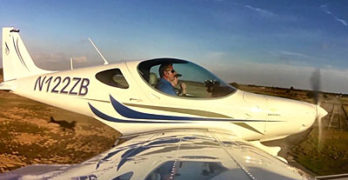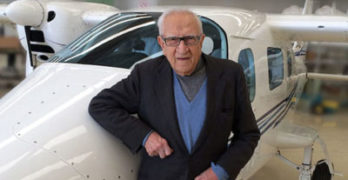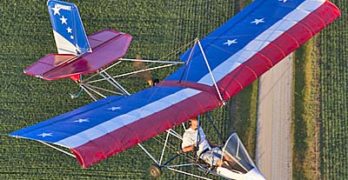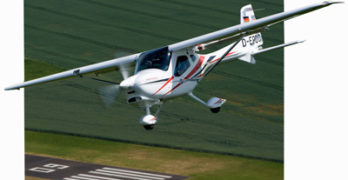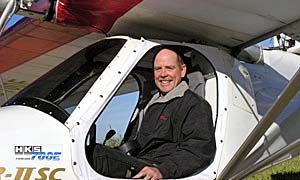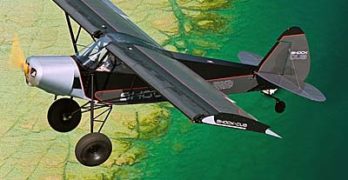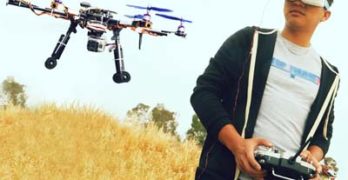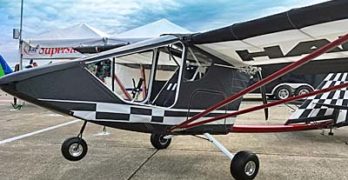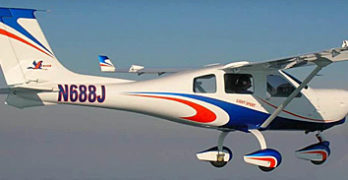“It cannot be done,” is the quick dismissal from many in aviation, referring to instrument flying in a LSA. In 2017, I venture to say everyone in aviation (worldwide) knows about Light-Sport Aircraft and the Sport Pilot certificate, but a superficial knowledge can be a bad thing. The details unveil more.
Think about IFR in an LSA this way: Can you fly IFR in a homebuilt aircraft? Can you do so in a Cessna 172? Does it matter that these two distinct types have not gone through a thorough IFR evaluation by FAA? If you know those answers then why should such flying be prevented in LSA?
It’s true, the industry committee called ASTM F.37 issued advice on this subject to LSA producers. F.37 is the group that has labored for a dozen years to provide FAA with industry consensus standards allowing FAA to “accept” (not “certify”) SLSA. The group has been working on a IFR standard for some time without arriving at consensus.
Search Results for : MG 21
Not finding exactly what you expected? Try our advanced search option.
Select a manufacturer to go straight to all our content about that manufacturer.
Select an aircraft model to go straight to all our content about that model.
He Built and Test Flew Airplanes for You!
We lost one of the good ones recently. You may not have met or even know this man, but you certainly know — and may absolutely love — the airplanes he created.
We say a sad and final farewell to Professor Luigi “Gino” Pascale.
While it is somewhat melancholy to bid farewell to this man of short stature but giant achievements, he did what he loved for seven decades and until very near the time of his death. None of us can ask for much more than that.
Luigi is also succeeded by family members who continue to run and expand the operation he began with his brother Giovanni so many years ago. Officially he was chief preliminary design officer of Costruzioni Aeronautiche Tecnam but Tecnam team members remember him fondly as the heart and soul of Tecnam. He was 93 at his passing.
Professor Luigi — as I heard several Tecnam employees refer to him — got his start in aviation designing model airplanes way back in the 1930s.
Quick Update on Quicksilver… Parts Are Shipping!
One of the major stumbles in the light aircraft world was the closure of Quicksilver Aeronautic’s southern California factory in Temecula. That ended a long-running era dating back to the 1970s. See articles here and here. Plenty of folks expressed concern.
Their worry was warranted. As a kit supplier, Quicksilver was one of the most prolific in aviation history with more than 15,000 kits delivered, nearly every one of which got airborne after the short build time. Some have been retired due to age, accident, or neglect, but many thousands continue to fly.
What happens when that large fleet can no longer buy parts? With the factory closed, are all those owners orphaned, having no factory-fresh parts available?
Don’t worry, be happy (so the song said).
“We currently have all the Quicksilver parts in stock and are shipping mass quantities daily,” said Gene “Bever” Borne, of Air-Tech, Inc.
Aero 2017 Approaches; Remos GXiS & More
We are fast approaching an important time of year… only this year I am a bit conflicted. The good news is Sun ‘n Fun and Aero Friedrichshafen are terrific shows. I have been attending both for more years that I care to admit. (OK, I guess I don’t ming saying Aero 2016 was my 20th in a row. I’ve been going to Sun ‘n Fun so long, it makes me feel old to say how many years it has been.)
Both events are vitally important to the light aircraft space I enjoy and as steadily reported on this website. Both have strong sectors serving Light-Sport Aircraft (and in Europe, LSA-like aircraft) plus light kit-built aircraft and ultralight aircraft (in Europe called 120-kilogram class or SSDR, which means Single Seat De-Regulated).
These classes of aircraft are the ones I love to report and probably the ones you also enjoy.
Watch for a Whole New Look… Very Soon!
For thirteen years, ByDanJohnson.com has served the light aircraft community, covering Light-Sport Aircraft, light kit-built aircraft, and ultralight aircraft. Along the way, we’ve covered all manner of interesting light aircraft from the tiniest drones to the emerging new-style certified GA aircraft from producers of LSA. As my outgoing webmaster said, “It’s been quite a ride!”
Of, course, since ByDanJohnson.com has been live for 13 years (almost to the day, which will be April 1st, 2017), this website preceded social media and even giants like YouTube. The website you have been so loyally visiting was assembled using the fairly crude tools available at the beginning of this new millennia. However, now that we are 17 years into the new century, it is time for a change… a BIG change.
In just a few days, after we check and recheck, adjust and tweak, we will hit the button for our “beta launch” of an entirely new look and feel.
Shock Treatment for Real Get-Up and Go
Once upon a time, the producer of a yellow LSA taildragger installed the industry’s most powerful engine resulting in a performance leader. This gambit succeeded handily and the builder enjoyed several strong years of sales. Others looked upon this success and saw that it was good.
So, of course, being aviation entrepreneurs, others worked to do the original one better. How about not only an excess of power but other features and macho good looks to cause jaw-drops at every airshow? You may believe I am writing about Just Aircraft and their magnificent SuperSTOL. I’ve enjoyed flying this aircraft and you can research it further here.
Adding exceptional wing qualities to a potent engine results in a sub-market within the LSA sector that has been drawing strong interest and the sales that follow. With newcomers offering appealing features and reducing the price into more affordable realms, it’s not hard to see why pilots are learning about these new flying machines and bringing one home.
The Future of Flying… Could It Happen?
Two forms of flying are racing at us at increasing speed. This is both scary and promising at once. What can we expect? My crystal ball is no better than yours, but let me tell you what I can imagine may be headed our way.
I refer to two generally unrelated activities in the air: autonomous aircraft and FPV drones. Most pilots to whom I’ve spoken seem intrigued by these innovations and a few are enjoying their quadcopters, myself included.
Others are not so sure if they like the idea of either unmanned but man-carrying aircraft or a swarm of drones buzzing about the airport or neighborhood. I understand this viewpoint. Most of us treasure our privacy and don’t want it invaded.
Yet I invite you consider the following scenario… perhaps 3-10 years in the future.
Think about why you like recreational flying, in your LSA, light kit, or ultralight.
Hawk is Finally Back and Looking Good
At Sebring 2017, another long-awaited aircraft emerged… or re-emerged. After wandering for a few years since original Hawk developer Chuck Slusarczyk retired and sold his company, the once-popular design has a new home in central Florida.
I’ve written about this before (earlier article), but we hadn’t seen much until Sebring 2017.
The season-starting Sebring Expo brought the debut of CGS Hawk now making its home in the sunshine state after migrating from Ohio to Alabama. Thanks to accomplished kit builder and restorer, Terry Short, this celebrated brand that once held a major presence in the ultralight aircraft space has returned. A refreshed Hawk was looking good.
Indeed, Terry beamed when he told me that he’d already sold six aircraft (recently; not all at the show), most of them the two-seat variety as shown in the nearby photos plus one Part 103 ultralight.
Because original designer Chuck Slusarczyk won FAA acceptance for an ASTM-compliant model, Terry can supply a fully built Special Light-Sport Aircraft version and at Sebring 2017 he told me that he fully intends to do so.
Video — BushCat Is Fun and a Bargain!
Are Light-Sport Aircraft too expensive? With yellow taildraggers from some companies exceeding $200,000, it certainly sounds so. Gorgeous and modern carbon fiber LSA run $125,000 to $180,000. So, yeah, if your budget is leaner or if you merely want to keep the price tag down for a recreational aircraft, it’s tougher than imagined before the SP/LSA regulation was announced in 2004.
Tougher, but not impossible. In fact, I’ve long maintained that we do have more reasonably priced LSA for sale but some folks want the more expensive, every-bell-and-whistle aircraft even while they resist the prices such gear costs. Our PlaneFinder 2.0 feature tries to address this with a price above-or-below $100,000. Even determining that can be difficult as some aircraft offer most optional equipment as standard while others prefer a very basically equipped airplane for a low price and let buyers add the stuff they want. Fair enough; a free market in aircraft should offer more choices and let the buyer decide.
Video—Jabiru J-230D Reviewed at Midwest LSA
Why do we go to all the little airshows? Good question. Everyone knows that a professional journalist or true-blue aircraft enthusiast almost has to trek to the big events like AirVenture or Sun ‘n Fun — with the latter coming up soon April 4-9, 2017. Fine. Yet are the smaller events worth the travel expense and time?
For Videoman Dave and I this is a no-brainer. Gotta go! Why? Because events like Sebring just finished or DeLand‘s end-of-the-season show or the Mid-West LSA Expo early in September in Mt. Vernon Illinois (about an hour’s drive east of St. Louis) are perfect for us to collect video footage and flying experiences that we can relate to viewers on Dave’s widely-watched YouTube channel (to the tune of a million and a half minutes every month!) or here on our LSA Video page.
- « Previous Page
- 1
- …
- 45
- 46
- 47
- 48
- 49
- …
- 94
- Next Page »


